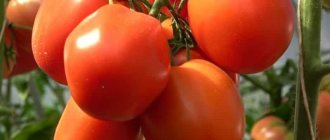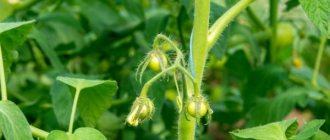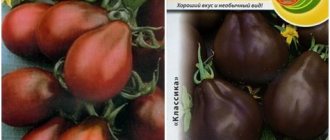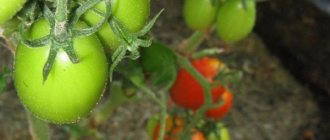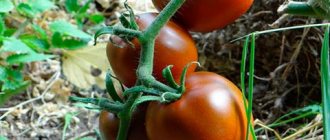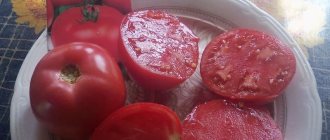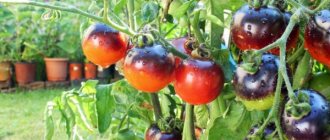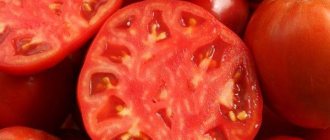The Grushovka tomato was born thanks to Russian breeders 20 years ago. Tomatoes have an interesting, presentable shape like a pear, as well as a bright crimson color.
| Height | Landing location | Ripening time | Fruit color | Fruit size | Origin | Fruit shape |
| Medium height | Greenhouse, Open ground | Mid-season | Pink | Average | Variety | Pear-shaped |
Description of the Grushovka tomato and its characteristics
The Grushovka tomato varieties were bred by Siberian breeders in the late 90s of the last century - in the early 2000s of this century. They were entered into the State Register of the country in 2001. There are several types of Grushovka, these are:
- Moscow Grushovka;
- Khabarovskaya Grushovka;
- Pink pear;
- Red pear;
- Yellow pear.
All these species are characterized by high yields, ease of cultivation and care, as well as early ripening. They differ in color, shape, size and cultivation regions. Suitable for both open and greenhouse cultivation.
What is a plant
The bushes are characterized by compactness and short stature:
- their growth does not reach a height of more than 60-65 cm;
- the central stem is thick and strong, however, in order to avoid breakage from the weight of the harvest, it is advisable to tie up the bushes;
- leaves are medium in size, heavily pubescent, dark green in color;
- The bush practically does not form stepsons, and therefore does not require stepsoning. It is only necessary to cut off the lower leaves as the bush grows;
- plants are determinant. They stop their growth when 5-7 clusters are formed on the bush, on each of which 5-6 tomatoes ripen;
- plants need help with pollination - shake slightly during flowering. It is worth knowing that the pollination process can be hampered by high humidity in the greenhouse;
- in open ground, pollination occurs naturally, and fruit set does not depend on weather conditions.
Appearance and taste of fruits
Grushovka tomatoes are very attractive to look at:
- the weight of the fruit ranges from 100 to 150 g. There are individual specimens whose weight reaches 250 g;
- The shape of the tomatoes is unusual, pear-shaped (wide base and narrow top). The shape of the Khabarovsk Grushovka resembles a pepper. The surface of the fruit is smooth and shiny;
- the color depends on the variety. It can be deep red, raspberry pink or yellow-orange;
- the juicy, fleshy and very aromatic pulp is covered with a thin but dense skin, which is not felt at all when eating;
- The taste of the fruit is magnificent, sweet with a slight sourness.
100 g of tomato pulp contains:
- carbohydrates - about 5 g;
- proteins - 1.2 g;
- fat - 0.3 g;
- water - at least 93 g;
- fiber - 0.8 g;
- organic acids - 0.5 g;
- pectin - 0.3 g;
- ash - 0.5 g.
The energy value of 100 g is only 23 kcal.
Application
In addition to the fact that the fruits of Grushovka have an excellent taste and are consumed fresh, they produce excellent tomato juice, tomatoes in their own juice, both pureed and whole and cut into pieces, high-quality tomato paste, as well as various ketchups. The fruits of the hybrid are used to make preparations for the winter - pickled tomatoes, assorted tomatoes, various marinades, salads and snacks. They are added to various meat and vegetable dishes, as well as pizza and shawarma.
When it starts to ripen
Grushovka is a hybrid of mid-early ripening. Its growing season is 110-115 days from the moment the first shoots appear. The first fruits begin to set in early July. Clusters with ovaries appear on the bushes one after another. A maturation process also occurs. The fruits are removed as they ripen.
Yield indicator
Grushovka is characterized by stable high yield. With good care, 5-6 kg of tomatoes are removed from one plant, and a little more than 9 kg from one square meter.
Relation to weather conditions and growing regions
This type of tomato is characterized by high cold resistance. It tolerates sudden temperature changes and hot weather well. During heat and drought, additional watering is required. High humidity and cloudy weather can cause fungal diseases, as well as problems with fruit set.
This hybrid is cultivated throughout our country. In the southern regions and in the Middle Zone it is grown in open ground, and in more northern regions - in the North-West, Siberia and the Urals - using the greenhouse method. Weather conditions do not affect fruit ripening.
Lightness and transportability
Thanks to their thick skin, Grushovka fruits are stored very well, especially if they are picked slightly unripe. Tomatoes picked in the fall can be stored until winter if proper storage conditions are observed. The fruits are perfectly transported over long distances without losing their taste and presentation, for which the hybrid is valued both by private farms and by farmers who grow it for sale.
A variety for all occasions
The popularity of the Grushovka tomato variety is due to the excellent taste of the fruit, good yield and ease of care. Breeders are so fascinated by the characteristics of the variety that they are developing new varieties:
- Moscow pear tomato;
- Pink and red pear;
- Khabarovskaya Grushovka and others.
The Grushovka variety is characterized by small elongated fruits, slightly expanded at the bottom. The exception is the Moscow variety, whose fruits are slightly curved and look more like pepper fruits. Depending on the variety, the color can be red or raspberry pink.
The skin and pulp are dense, the tomatoes are juicy, weighing about 100 - 150 grams, with a characteristic, slightly sour taste. On a cluster it forms 4–5 fruits of approximately the same size, ripening at the same time. The yield from one Grushovka bush can be up to 4 kilograms.
The plant itself is low, compact, and does not require pinching or staking. In a greenhouse it can become very stretched, then the bush will need to be tied to a support. The tomato is unpretentious to conditions and can grow both in open ground and in greenhouses. Tomatoes from the Khabarovsk selection are more suitable for cold regions.
The description of the variety characterizes it as a determinant mid-season with a ripening period of 100 - 120 days. Reviews about the tomato are mostly positive; among summer residents the variety is popular as a pickling variety, since the small, dense fruits easily fit in a jar and retain their shape after long-term storage and preservation. Grushovka has a long shelf life and good transportability when fresh.
You can buy Grushovka seeds at a regular gardening store or order through an online store. The sold seeds of the variety are packaged in different packages, which is explained by different manufacturing companies.
As a rule, gardeners purchase a bag from a company whose products they are familiar with and whose quality they trust. The cost of Grushovka seeds can vary greatly depending on the manufacturer, but not only. The number of seeds also affects the price, so this fact is worth paying attention to.
Diseases and pests
Grushovka does not have good immunity to a number of diseases and can be affected by:
- blossom-end rot, the causes of which can be many - from improper soil acidity to illiterate care of bushes. To prevent disease, the seeds must be kept for several minutes in a weak solution of potassium permanganate before planting. It is also necessary to maintain the required temperature and humidity in the greenhouse. Do not loosen the soil around the bushes too much. This can damage the roots. If the disease appears, the affected fruits must be destroyed and the plants treated with an aqueous solution of calcium chloride (40 g of the drug per 10 liters of water);
- macrosporiosis, caused by sudden changes in temperature, from which the fungus begins to multiply. Symptoms are round dark spots on the leaves, petioles and fruits, which merge over time, and parts of the plants dry out and fall off. Prevention - choosing healthy seeds, disinfecting them and the soil before planting, cleaning the greenhouse from weeds and organic debris, treating seedlings and affected bushes with a 1% solution of Bordeaux mixture;
- viral mosaic. Symptoms are the appearance of yellow spots on the leaves with a bright border, as well as deformation of the fruit. At the first signs, the bushes are treated with a solution prepared from 10 liters of water, a liter of milk and 10 drops of iodine, as well as Lamador and Maxim fungicides.
Blossom rot of tomatoes.
As a preventative measure, bushes must be treated against insect pests such as aphids, spider mites, slugs, whiteflies, etc. For this, appropriate insecticides are used.
Growing rules
To plant a tomato, you must follow the following rules:
- Planting is done on the sunny side of the site.
- Carry out regular watering. Sometimes each bush requires up to 15 liters per week.
- Do not pick fruits prematurely. Nutrient availability will be below normal.
- Seedlings are fertilized at an early stage of growth and after planting in the ground.
- For 1 sq. m, 4-5 bushes are planted.
- They tie it up on time.
- Regularly hill up the bushes to supply oxygen to the soil.
Planting seedlings
It is necessary to prepare soil for planting in the fall. The soil is saturated with oxygen and left in a cold place until the beginning of spring. During the winter the soil will freeze and there will be no larvae in it that eat the tomato seeds. At the time of planting, the soil is mixed with mineral fertilizers, compost, sand, and humus. You can also purchase high-quality soil at any hardware store.
Any container for seedlings is suitable: pots, boxes, trays with individual compartments for each seed. The container is washed, disinfected with a solution of diluted potassium permanganate, rinsed and left to dry.
Seeds can be purchased new or used from a previous planting. First, the seeds are checked for germination. To identify dummies, seeds are immersed in water for 10 minutes; the dummies will float to the surface. Seeds should be germinated at room temperature, in damp cotton cloth. Add water daily. On day 5-6, the seeds are planted in the ground.
The first shoots appear on the 3-4th day. It is necessary to control soil moisture; too much water will kill crops. Seedlings are ready for picking at a height of 7-10 cm, when 2-3 true leaves are fully formed. Plastic glasses are suitable for individual containers. The stem of the seedling is buried before the leaves begin to grow. Then the seedlings are watered every 2-3 days.
Tomato transplant
Transplantation into beds is carried out at a constant temperature from +15 to +18°C. They make beds and fertilize them with compost or manure. Tomatoes are ready for planting when they are 15-20 cm tall. Planting is done at a depth of 10-15 cm so that the stem stands at a right angle. The distance between the bushes is up to 50 cm. After planting, the seedlings are watered. Pear tomatoes should not be watered with cold water. Experienced gardeners who grow Pear tomatoes recommend planting 4-5 plants per 1 square meter. m.
Subsequent care for tomatoes
A drip irrigation system is installed in the greenhouse; it can be automated. Fertilizing is carried out once a week, in a good microclimate once every 2 weeks. Mulch when the soil is stagnant at the roots of tomatoes.
- Disinfect equipment: garden shears, pruning shears. You can use regular scissors.
- At a distance of 1 cm from the base of the stem, the stepsons are cut at right angles.
- After cutting the shoots from one bush, the tool is disinfected.
The example shows the stepsons that need to be deleted:
Tomatoes are tied up when they are 60-70 cm tall. At this point the bushes begin to spread along the ground, and the ovary of the flowers is visible. The garter allows natural light to flow openly. They tie it to a peg, a net, or make a frame with a garter on ropes.
Pros and cons of a hybrid
With a minimum number of disadvantages, and this is vulnerability to diseases and pests, the hybrid has a huge number of advantages. Grushovka is characterized by:
- compact bushes that do not require pinching;
- high productivity;
- early ripening;
- sizes suitable for canning;
- excellent taste of tomatoes and their excellent presentation;
- long shelf life and the possibility of transportation over long distances;
- ripening of fruits in any weather.
A selection of reviews from amateur gardeners
The Grushovka tomato is actively planted by residents of Siberia, the Urals, and the Far East. The variety takes root normally and bears fruit in the harsh conditions of these regions. Galina from Novosibirsk region. notes the compactness of the plants. From a small greenhouse area, the gardener gets a good harvest.
Lyudmila from Krasnoyarsk noted the taste of the fruit in her review. They are especially good when pickled. The strong skin prevents the tomato from cracking. This is an additional advantage of canning pear-shaped tomatoes. Valentina (Khakassia) noted the immunity of culture.
On thematic forums, gardeners participate in debates about several varieties, popularly called Grushevka. The most common varieties are from famous vegetable breeders Nikolai Egorov and Nikolai Alexandrov. Their cultures are similar. Only the first one has slightly smaller fruits, and the second one has lower bushes.
The pear-shaped tomato variety has proven itself over the years of cultivation. With a little care, the tomato shows decent yield and pleases garden owners.
How to grow
Grushovka is grown, like other varieties of tomatoes, using the seedling method. The quality of the subsequent harvest completely depends on the quality of the seedlings.
Growing seedlings
Growing seedlings is not at all difficult. You just need to follow the following rules:
- before sowing, the seeds are soaked for 30 minutes in a light pink solution of potassium permanganate, then dried in the open air;
- pour seedling soil, purchased in a store or prepared yourself, into containers or directly into separate pots, lightly moisten with water from a spray bottle and sow the seeds at a distance of 3 cm from each other, lightly pressing into the soil;
- cover the container with film and put it in a warm, dark place until the first shoots appear;
- as soon as the sprouts appear, the film is removed and the containers or pots are placed on a bright windowsill;
- after the appearance of the third leaf, the seedlings are planted if the seeds were sown in containers;
- Seedlings require care - watering, fertilizing and hardening, which is carried out 10 days before planting the seedlings in a permanent place of growth.
Landing
Seedlings are planted in the greenhouse in early May, and in open ground in early June. The soil is prepared in advance - dug up, cleared of weeds, and fertilized. Next, make holes at a distance of 30-40 cm from each other and plant seedlings in them, after adding a handful of ash, humus and 0.5 liters of water.
Care
Grushovka is easy to care for:
- It is necessary to water the tomatoes once every 7 days;
- loosen and weed the soil around the bushes;
- feed once every 2 weeks;
- pick off the lower leaves as the bush grows;
- tie the bush to a support.
Growing methods
The Red Pear tomato can be grown both according to the standard scheme - using seedlings, and without seedlings. Let's take a closer look at these two options.
Seedless method
Using this method, you can plant tomatoes both in a greenhouse and outdoors. Below are the most important points.
Soil preparation
The Red Pear variety places increased demands on the soil in which it grows.
It is very important that the soil is fertile, fertilized and loose
To ensure that the soil in the garden bed meets these requirements, dig it up before planting, loosen it and apply fertilizer:
It is better to fertilize at the same time as digging so that the minerals get into the lower layers of the soil.
Planting Tips
- Sow the seeds in such a way that there is a distance of 35-40 cm between them. Thickening is unacceptable, as it leads to loss of yield and crop diseases.
- Water the bed after sowing using warm water. If we are talking about open ground, cover the plantings with lutrasil or film on top: this measure will protect the seedlings from cold snaps.
Seedling method
A much more commonly used method. In our climate, it is the seedling option that leads to high and predictable yields.
Deadlines
To plant seedlings in the ground in May, the seeds should be planted a couple of months before this event. Optimal sowing dates: late winter - early spring.
Preparation
If you purchased the seeds in a store, there is no need for pre-sowing preparation. But if you harvested it yourself, we recommend treating the seeds in a solution of potassium permanganate. One and a half to two hours is enough to protect future tomatoes from fungus.
Priming
It is better to sow the seeds in a special seedling soil mixture sold in the store. The composition of such a mixture has already been thought out and balanced: no additional loosening or fertilizing is needed.
If you prepare the soil mixture yourself, be sure to disinfect the soil and apply the following fertilizers:
- potassium;
- phosphorus;
- growth stimulant;
- wood ash.
Conditions for seedlings
It is very important for the successful cultivation of tomato seedlings to ensure:
- competent and regular watering;
- long daylight hours;
- warm and mild microclimate.
Temperature
In order for the heat-loving crop to develop quickly and correctly, maintain the room temperature at +20-22 degrees. Remember that until the shoots appear, the temperature should be higher: +25-27 degrees.
Lighting
The place where the seedlings are located should be illuminated most of the day. As a rule, daylight hours are still short in March, so take care of additional lighting.
Picking
This procedure is performed when the seedlings form 2-3 leaves. Note that this tomato variety tolerates picking perfectly and without negative consequences.
Disembarkation
Tomato seedlings should be transplanted to an outdoor garden bed or greenhouse when the soil warms up to +15-18 degrees. It is clear that in greenhouse conditions, planting can be done much earlier. They are usually planted outside at the end of May, sometimes at the beginning of summer.
Let's get acquainted with the features of caring for red pear tomatoes.
Top dressing
Tomatoes need two minerals in particular: phosphorus and potassium. Apply these microelements throughout the growing season, keeping a break of 4 weeks between feedings. Before fruit ovaries begin to form, nitrogen fertilizing is also recommended.
In addition to mineral supplements, you can also use folk remedies:
Loosening
The soil in the tomato bed should always remain permeable. To achieve this, be sure to loosen the soil after watering and rain (if we are talking about open ground).
Pruning, pinching
Since the variety is indeterminate, the above procedures cannot be avoided. Usually the bush forms one or two stems - this is quite enough to achieve the optimal ratio of the size of the fruits and their quantity.
Fertilizing
If the soil on the site is not fertile, it is recommended to apply mineral and organic fertilizers.
- 7-10 days after planting, the first fertilizing is carried out. You can use different mixtures. In 10 liters of water, dilute a tablespoon of nitrophoska and half a liter of liquid manure or a tablespoon of “Ideal” factory fertilizer. Half a liter of solution is poured under the Grushovka tomato bush.
- During the flowering period, a solution is used: add 0.5 liters of chicken manure, a tablespoon of superphosphate and a teaspoon of potassium sulfate to 10 liters of water. The mixture is thoroughly stirred and a liter of solution is poured under each bush.
- When Grushovka tomatoes begin to ripen, it is necessary to use fertilizers containing boron, iodine, manganese, and potassium. These elements will ensure high yields of juicy and fleshy Grushovka tomatoes. To prepare the fertilizer, take 10 liters of water, 10 g of boric acid (powdered), 10 ml of iodine, 1.5 liters of ash (well sifted). The mixture is carefully stirred and poured under the bush, one liter at a time.
To accelerate the setting and ripening of tomatoes of the Grushovka variety, foliar feeding is carried out. To do this, dilute 50 g of superphosphate in 10 liters of hot water. The solution should stand for a day and then each bush is sprayed with 10 ml of the composition.
It is better to apply any types of fertilizing in dry weather in the morning or evening. The best option is to combine this procedure with watering the tomatoes. You can alternate different ways of feeding Grushovka tomatoes.
